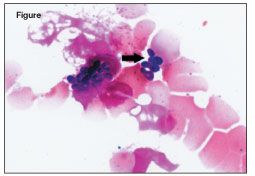- Clinical Technology
- Adult Immunization
- Hepatology
- Pediatric Immunization
- Screening
- Psychiatry
- Allergy
- Women's Health
- Cardiology
- Pediatrics
- Dermatology
- Endocrinology
- Pain Management
- Gastroenterology
- Infectious Disease
- Obesity Medicine
- Rheumatology
- Nephrology
- Neurology
- Pulmonology
An Unusual Cause of Fungemia
A 70-year-old man was admitted with a change in mental status and shortness of breath. He had a history of carcinoma of the colon and status postcolectomy with ileostomy. He was receiving long-term total parenteral nutrition, including lipid emulsion, for short-gut syndrome. Other pertinent findings in the medical history included type 2 diabetes mellitus and enterocutaneous fistula.
A 70-year-old man was admitted with a change in mental status and shortness of breath. He had a history of carcinoma of the colon and status postcolectomy with ileostomy. He was receiving long-term total parenteral nutrition, including lipid emulsion, for short-gut syndrome. Other pertinent findings in the medical history included type 2 diabetes mellitus and enterocutaneous fistula.
On examination, the patient was tachypneic, with a respiration rate of 28 breaths per minute; his heart rate was 104 beats per minute; his blood pressure was 118/62 mm Hg; and his temperature was 37.2°C (99°F). Auscultation of his chest revealed scattered rhonchi. The Hickman catheter site was not erythematous or tender to palpation. A chest radiograph did not show infiltrates. Arterial blood gas values on forced inspiratory oxygen of 30% included a pH of 7.41, Pco2 of 35.2 mm Hg, Po2 of 111.6 mm Hg, and bicarbonate level of 22.5 mEq/L. The total white blood cell count was 15,800/µL, with 74% segmented neutrophils and 10% bands. A peripheral blood smear demonstrated numerous budding yeasts (Figure, Wright stain, original magnification ×100).

A catheter-related fungemia was considered, and the Hickman catheter was removed. Therapy was started with amphotericin B. Blood cultures drawn from the Hickman catheter grew Malassezia furfur. Amphotericin B therapy was continued for 10 days, with the patient making an uneventful recovery. Three months later, the patient died of unrelated surgical complications.
DiscussionM furfur is a lipophilic yeast that colonizes human skin and causes superficial infections such as tinea versicolor. Rarely, it is the cause of catheter-related sepsis. Most reported cases have been in patients who were receiving parenteral lipids via a central vascular catheter.1 Most patients were either neonates or adults with malignancy or immunosuppression.2 The symptoms are indistinguishable from those of sepsis from any other cause.
M furfur does not grow readily on standard fungal media; it requires fatty acid for growth. Blood cultures from a central catheter source have a better yield than those from peripheral sites.3 A positive peripheral blood smear, as seen in this case, is rare.4Malassezia fungemia should be considered in the workup of sepsis in patients with a central catheter who are receiving hyperalimentation with lipids, and the laboratory should be alerted so that oil-rich media can be used.
Treatment consists of removal of the catheter and discontinuation of lipids, along with administration of amphotericin B or imidazoles for persistent or invasive infections.5
References:
REFERENCES
1. Dankner WM, Spector SA, Fierer J, Davis CE. Malassezia fungemia in neonates and adults: complication of hyperalimentation. Rev Infect Dis. 1987;9:743-753.
2. Barber GR, Brown AE, Kiehn TE, et al. Catheter-related Malassezia furfur fungemia in immunocompromised patients. Am J Med. 1993;95:365-370.
3. Marcon MJ, Powell DA. Human infections due to Malassezia spp. Clin Microbiol Rev. 1992;5:101-119.
4. Brooks R, Brown L. Systemic infection with Malassezia furfur in an adult receiving long-term hyperalimentation therapy. J Infect Dis. 1987;156:410-411.
5. Weisse ME. Malassezia furfur. In: Behrman RE, Kliegman R, Janson HB, eds. Nelson Textbook of Pediatrics. 16th ed. Philadelphia: WB Saunders; 2000:937.
